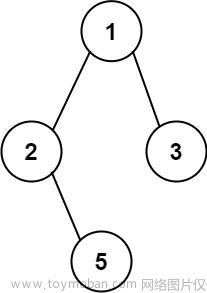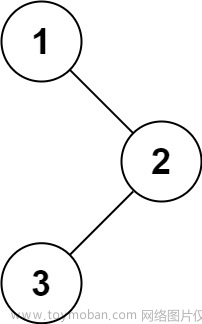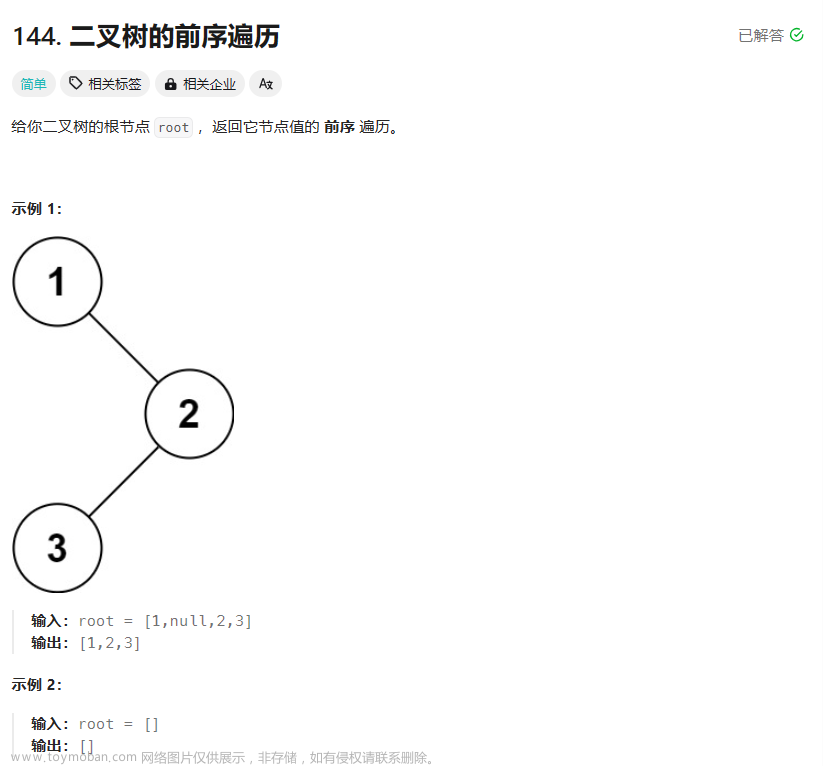题目来源:https://leetcode.cn/problems/binary-tree-paths/description/

C++题解1:使用递归,声明了全局变量result,遇到叶子节点就将字符串添加到result中。
递归三步法:
1. 确认传入参数:当前节点+已有路径(字符串);
2. 确认终止条件:遇到叶子节点,即左右节点都为空时,将当前节点添加到路径中,再将此条路径添加到result中;
3. 确认单层递归逻辑:路径添加 “->”,分别获取左右子树的路径。
/**
* Definition for a binary tree node.
* struct TreeNode {
* int val;
* TreeNode *left;
* TreeNode *right;
* TreeNode() : val(0), left(nullptr), right(nullptr) {}
* TreeNode(int x) : val(x), left(nullptr), right(nullptr) {}
* TreeNode(int x, TreeNode *left, TreeNode *right) : val(x), left(left), right(right) {}
* };
*/
class Solution {
public:
vector<string> result;
void getlujing(TreeNode* node, string s) {
if(node->left == nullptr && node->right == nullptr) {
s = s + to_string(node->val);
result.push_back(s);
return ;
}
s = s + to_string(node->val) + "->";
if(node->left) getlujing(node->left, s);
if(node->right) getlujing(node->right, s);
}
vector<string> binaryTreePaths(TreeNode* root) {
getlujing(root, "");
return result;
}
};C++题解2(来自代码随想录):同样使用递归,明显看出回溯,对路径和result的调用均为引用。文章来源:https://www.toymoban.com/news/detail-510433.html
class Solution {
private:
void traversal(TreeNode* cur, vector<int>& path, vector<string>& result) {
path.push_back(cur->val); // 中,中为什么写在这里,因为最后一个节点也要加入到path中
// 这才到了叶子节点
if (cur->left == NULL && cur->right == NULL) {
string sPath;
for (int i = 0; i < path.size() - 1; i++) {
sPath += to_string(path[i]);
sPath += "->";
}
sPath += to_string(path[path.size() - 1]);
result.push_back(sPath);
return;
}
if (cur->left) { // 左
traversal(cur->left, path, result);
path.pop_back(); // 回溯
}
if (cur->right) { // 右
traversal(cur->right, path, result);
path.pop_back(); // 回溯
}
}
public:
vector<string> binaryTreePaths(TreeNode* root) {
vector<string> result;
vector<int> path;
if (root == NULL) return result;
traversal(root, path, result);
return result;
}
};C++题解3(来自代码随想录):迭代法,除了模拟递归需要一个栈,同时还需要一个栈来存放对应的遍历路径。文章来源地址https://www.toymoban.com/news/detail-510433.html
class Solution {
public:
vector<string> binaryTreePaths(TreeNode* root) {
stack<TreeNode*> treeSt;// 保存树的遍历节点
stack<string> pathSt; // 保存遍历路径的节点
vector<string> result; // 保存最终路径集合
if (root == NULL) return result;
treeSt.push(root);
pathSt.push(to_string(root->val));
while (!treeSt.empty()) {
TreeNode* node = treeSt.top(); treeSt.pop(); // 取出节点 中
string path = pathSt.top();pathSt.pop(); // 取出该节点对应的路径
if (node->left == NULL && node->right == NULL) { // 遇到叶子节点
result.push_back(path);
}
if (node->right) { // 右
treeSt.push(node->right);
pathSt.push(path + "->" + to_string(node->right->val));
}
if (node->left) { // 左
treeSt.push(node->left);
pathSt.push(path + "->" + to_string(node->left->val));
}
}
return result;
}
};到了这里,关于力扣 257. 二叉树的所有路径的文章就介绍完了。如果您还想了解更多内容,请在右上角搜索TOY模板网以前的文章或继续浏览下面的相关文章,希望大家以后多多支持TOY模板网!











